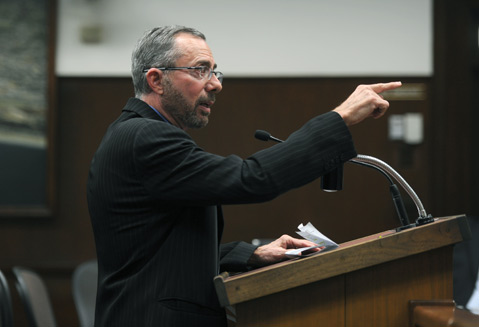
With a discussion of district elections came two disparate messages: Don’t rush a decision, but get ready to get sued. Such was the scene at the Santa Barbara City Council meeting on Tuesday, when the councilmembers heard from a handful of public speakers and talked among themselves about examining the idea of asking voters in November to potentially change the city’s current at-large election system, meaning officials represent the entire city, to one based on districts, meaning they would only represent a designated area.
But at the same time, the council was urged to take the process slowly — councilmembers voted 7-0 to hold a public workshop in May to hear what type of change residents might want — they were warned by lawyer Barry Cappello that the pro-districts lawsuit he has been planning for months should still be expected.
In their request to have the hearing, Mayor Helene Schneider and Councilmember Bendy White suggested asking voters to implement a compromise system, under which four members would be elected based on districts, and two members and the mayor would be elected citywide. But Cappello wasn’t buying it. “Probably the only good hybrid I can think of is Prius,” he said. “To do it right, you need to have district elections.”
Cappello’s pending lawsuit — he said his team is still preparing it — would argue that Santa Barbara’s at-large system makes for underrepresentation on the council, particularly among Latinos, and consequently violates the California Voting Rights Act. If a judge found that to be true, the city’s at-large system could be forced to switch to districts. Similar scenarios have played out in cities across the state, including Palmdale, which is the first city in California to have its system undergo court-ordered change.
Spending time discussing a hybrid plan would therefore be a “waste of time,” Cappello argued, as the court would view that as akin to an at-large system. He cited what he said were residents’ unheard requests for streetlights, bridge repairs, and anti-crime measures in advocating for the switch. Cappello — who served as City Attorney during the 1970s when the city’s system flipped, as it has before, from district elections to at-large — said repeatedly that his comments were “not a threat.”
“Mr. Cappello didn’t threaten a lawsuit. He promised one,” he said.
Current City Attorney Ariel Calonne disagreed. “Mr. Cappello didn’t threaten a lawsuit. He promised one,” he said. Calonne — who recently came to the city after working for Ventura, which has put an even-year proposal on the November ballot — cautioned the council about a hybrid system. He said that if the city’s system were to be found in violation of the law, anything “less than pure district elections” could still be subject to a lawsuit. “The deck is truly stacked against at-large voting in California,” he said.
But the reaction from public speakers and councilmembers wasn’t decidedly behind districts, either. Many said more time for public input was needed at the very least — most balked at the idea of trying to get ballot language finalized by July, the deadline for the November ballot — and many also noted the myriad other ways to widen the candidate pool. Ideas included instituting even-year elections, playing around with different hybrid scenarios, and using cumulative voting where voters can select multiple people.
Councilmember Cathy Murillo, who attended a forum on district elections in February and is the only Latina to ever hold a council seat, called the lawsuit a “shortcut” to effective change and said that along with campaign finance reform, cultivation of candidates is key. “I worked and I walked and I got elected, and that’s what it takes in this town,” she said.
Councilmember Frank Hotchkiss took issue with the need for a change in the first place. “From the get-go, I’ve felt that the responsibility of everybody up here is to the whole city and not to one part or the other,” he said, voicing concerns about the “Balkanization” of the city. Councilmember Randy Rowse questioned the motive behind the hearing, asking, “Are we talking about doing the right thing, or are we talking about covering our rear ends collectively?”
A representative from Central Coast Alliance United for a Sustainable Economy (CAUSE) cautioned the council against moving too quickly. CAUSE helped gather more than 5,000 signatures in support of district elections in Santa Maria, but that city attorney found their petition invalid; the decision to accept the signatures will now be up to a judge.
White, one of the two on the dais to suggest the discussion, seemed pleased that the discussion would be continuing: “I have my antenna up and my ears open, and that’s the most important ingredient right now — to hear what the community has to say.”



